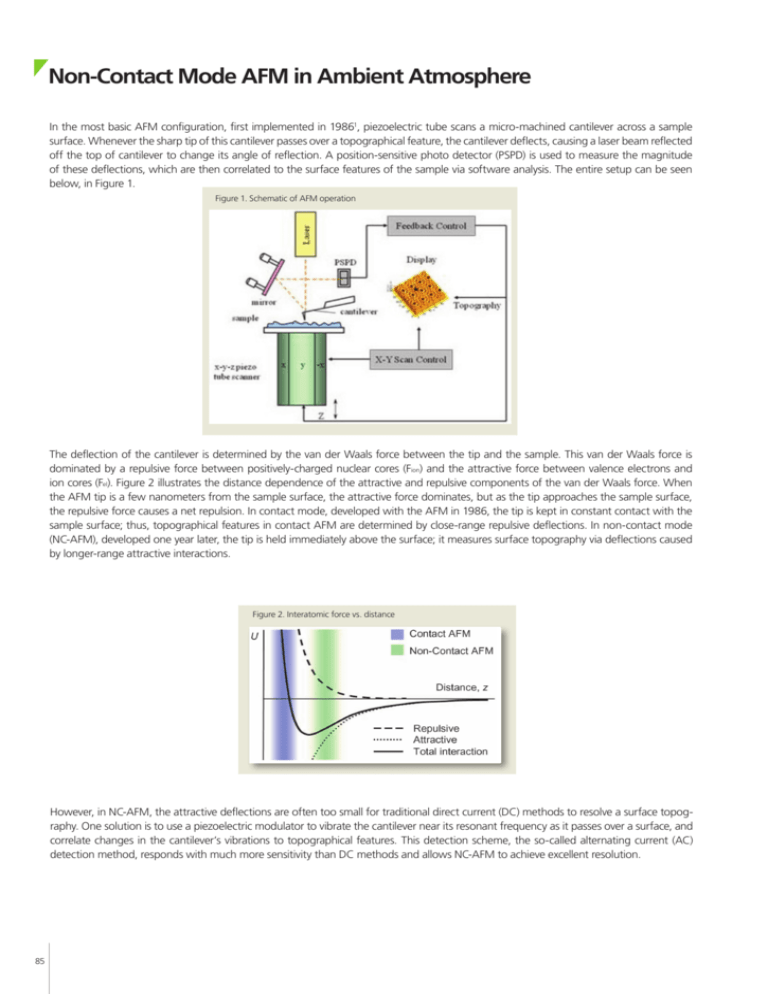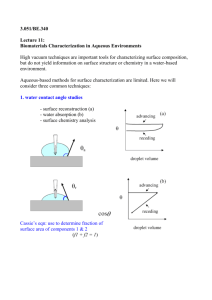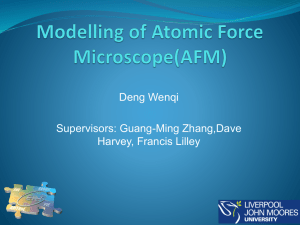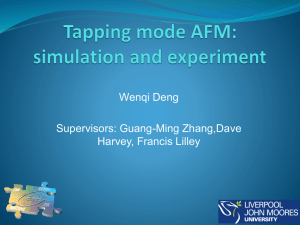Non-Contact Mode AFM in Ambient Atmosphere
advertisement

Non-Contact Mode AFM in Ambient Atmosphere In the most basic AFM configuration, first implemented in 19861, piezoelectric tube scans a micro-machined cantilever across a sample surface. Whenever the sharp tip of this cantilever passes over a topographical feature, the cantilever deflects, causing a laser beam reflected off the top of cantilever to change its angle of reflection. A position-sensitive photo detector (PSPD) is used to measure the magnitude of these deflections, which are then correlated to the surface features of the sample via software analysis. The entire setup can be seen below, in Figure 1. Figure 1. Schematic of AFM operation The deflection of the cantilever is determined by the van der Waals force between the tip and the sample. This van der Waals force is dominated by a repulsive force between positively-charged nuclear cores (Fion) and the attractive force between valence electrons and ion cores (Fel). Figure 2 illustrates the distance dependence of the attractive and repulsive components of the van der Waals force. When the AFM tip is a few nanometers from the sample surface, the attractive force dominates, but as the tip approaches the sample surface, the repulsive force causes a net repulsion. In contact mode, developed with the AFM in 1986, the tip is kept in constant contact with the sample surface; thus, topographical features in contact AFM are determined by close-range repulsive deflections. In non-contact mode (NC-AFM), developed one year later, the tip is held immediately above the surface; it measures surface topography via deflections caused by longer-range attractive interactions. Figure 2. Interatomic force vs. distance However, in NC-AFM, the attractive deflections are often too small for traditional direct current (DC) methods to resolve a surface topography. One solution is to use a piezoelectric modulator to vibrate the cantilever near its resonant frequency as it passes over a surface, and correlate changes in the cantilever’s vibrations to topographical features. This detection scheme, the so-called alternating current (AC) detection method, responds with much more sensitivity than DC methods and allows NC-AFM to achieve excellent resolution. 85 Mode Note Non-Contact AFM Martin et al developed the first NC-AFM in 19873, one year after the development of the contact AFM In NC-AFM, a piezoelectric bimorph is used to vibrate the cantilever near the cantilever’s intrinsic resonant frequency (f0), usually between 100 kHz and 400 kHz (350 kHz is the typical resonant frequency of a cantilever used in Park Systems’ True Non-Contact Mode), with an amplitude a few nanometers. As shown in Figure 3, this resonant frequency can be found by recording the amplitude of the cantilever’s vibration while scanning the frequency of the voltage applied to the bimorph. This resonant vibration has a corresponding spring constant (k0), described by Equation (1) below. (1) As the tip approaches a sample, the van der Waals force between the tip and the sample changes the amplitude and phase of the cantilever’s resonant vibration, resulting in a new effective resonant frequency (feff) and effective spring constant (keff). In the presence of an attractive force (i.e. the force gradient is positive), keff decreases as the tip is brought closer to the surface. As keff becomes smaller in the presence of an attractive force, feff also becomes smaller than f0, as shown in Figure 4. (2) Changes in the amplitude of vibration reflect changes in Δd, distance between the tip and the surface. By measuring these changes in amplitude (ΔA) at the resonant frequency of the cantilever, the NC-AFM feedback loop then compensates for Δd, as shown in Figure 5. While maintaining constant amplitude (A0) and distance (d0), the NC-AFM can measure the topography of the sample surface by controlling the Z-scanner movement in response to changes in frequency. These changes are monitored by a high-speed Z-servo feedback loop. Figure 3. Figure 4. Figure 5. Resonant frequency of a cantilever Resonant frequency shift Resonant frequency shift f1 Challenges of Non-Contact AFM in Ambient Atmosphere: Fast Z-Servo Feedback Modulated feedback mechanisms operate in both the attractive and repulsive interaction regimes.4 In the attractive interaction regime, the net attractive force between the tip and the sample dominates the amplitude reduction in the absence of real tip-sample contact. However, in the absence of sufficient mechanical control, the long-range attractive force causes the tip to overcome the short-range repulsive forces, leading to tip-sample contact at each end of the cantilever oscillation cycle. From the Amplitude vs. Distance plot shown in Figure 6, one can see that, for a tip oscillating with large free air amplitudes, only a very small portion of the tip’s motion lies in the attractive force regime. It is very difficult to keep the tip in such a tightly-defined region. With smaller free air amplitudes, such as those shown in Figures 7 and 8, a larger portion of the tip’s motion is within the attractive interaction regime. Such minute free-air amplitudes also require precise control and fast feedback response to track the changes in amplitude due to changing tip-surface interactions. www.parkAFM.com 86 Mode Note Figure 6. Amplitude vs. distance plot of a tip Figure 7. Amplitude vs. distance plot of a tip Figure 8. Amplitude vs. distance plot under the oscillating with large free air amplitude oscillating with small free air amplitude net attractive force regime True Non-Contact Mode by High Force Z-scanner in Crosstalk Eliminated (XE) AFM Figure 9. The crosstalk eliminated (XE) AFM with high force Z-scanner Most ambient AFM vendors, lacking Z scan actuators with the feedback control necessary to stay in the attractive force regime, elect to operate their systems in the repulsive force regime. Unfortunately, this decision means that their tips periodically come into contact with sample surface, wearing down tips and damaging the sample surface. Park Systems’ crosstalk eliminated (XE) AFMs, which utilize the flexure guided high-force Z-scanner shown in Figure 9, are much more sensitive and responsive to the minute amplitude changes caused by smaller frequency shifts in the attractive force regime. The fast response of Park Systems’ low-inertia z scanner allows precise tracking of movement at the end and even at the side of the AFM tip, allowing the tip to retract promptly when it encounters sharply-rising sample features (as shown in Figures 10 and 11) and stay in the attractive force regime without crashing onto the sample surface. With their high-force Z scanners actuated by patented multiple-stacked piezos, high-frequency cantilevers, and decoupled Z and XY scanners, Park Systems’ XE AFMs have the speed and control to realize True Non-Contact Mode. www.parkAFM.com 87 Mode Note Figure 10. Tip-sample interaction at the end and side of Figure 11. 3D rendering of 1 um scan image of 50 nm wide, 100 nm deep trenches, measured by the tip True Non-Contact Mode of the XE-100, is shown in 1:1 aspect. True Non-Contact Mode from the XE-series with high Z-servo performance can accurately trace the steep walls of the trenches. Reference 1. G. Binnig, C. Quate, and Ch. Gerber, Phys. Rev. Lett. 56, 930 (1986). 2. G. Meyer and N. M. Amer, Appl. Phys. Lett. 53, 2400 (1988). 3. Y. Martin, C.C. Williams, H.K. Wickramasinghe, J. Appl. Phys. 61, 4723 (1987). 4. R. Garcia, and A. San Paulo, Phys. Rev. B. 60, 4961 (1999). www.parkAFM.com 88





